Two enlisted Marines have been named the recently earned bragging rights as Corps' top tactical athletes following the service's first-ever annual High Intensity Tactical Training Ultimate Tactical Athlete Championship — a grueling three-day CrossFit Games-style competition that pitted some of the service's strongest troops against each other.
One male and one female Marine were crowned after proving themselves during the inaugural servicewide HITT Championship grueling three-day competition last month from Sept. 15 to 17 at the Marine Corps Air Ground Combat Center in Twentynine Palms, California. In all, 32 Marines from nearly every Marine installation squared off against each other The pairy re, 32 of the service's best athletes squared off with one another in a series of events that tested their physical mettle. emphasize functional fitness.
Staff Sgt. Lauren Schoener, 25, and Cpl. Joshua Boozer, 22, pulled ahead, acing the five-stage championship that which tested strength, endurance, agility, coordination and flexibility. Now they have champion belts — like those that boxers and UFC title champions win — to show for it.
Schoener, who serves in the Marine Corps Air Station Yuma's provost marshal's office at Marine Corps Air Station Yuma's, Arizona, is a CrossFit instructor in her off time. Boozer, an ammunition technician with 1st Tank Battalion at Twentynine Palms, was inspired by his sergeant major to get involved in basewide HITT competitions.
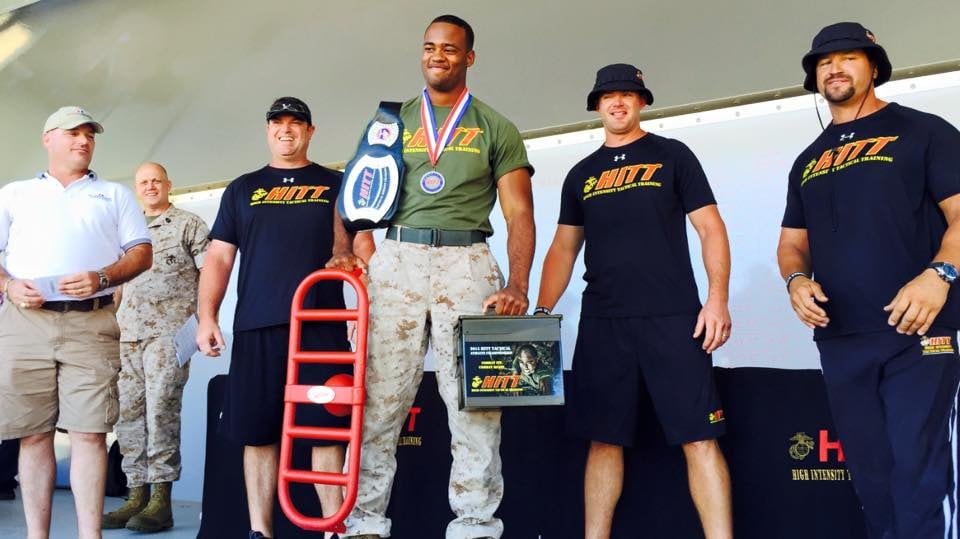
Cpl. Joshua Boozer, an ammunition technician with 1st Tank Battalion, was named the first male champion during the Corps' first annual High Intensity Tactical Training Ultimate Tactical Athlete competition.
Photo Credit: Marine Corps
"When I won it felt great," Boozer said Boozer, an ammunition technician with 1st Tank Battalion at Twentynine Palms. "I had some guys in my unit come by to watch me. ...and my sergeant major. When they called my name I saw a big smile on [my sergeant major's] Sgt. Maj. [Brian] Priester's face."
It's the first time Marines have seen a Corps-wide fitness match on this scale, but it has been years in the making. Soon after the Marine Corps launched its HITT program in 2012, officials were looking at ways to create a servicewide event that would build camaraderie and tap into Marines' competitive athletic spirit.
While this year is the service's first HITT championship, it has been in the works since soon after the HITT program was launched in October 2012. Soon after the program's roll out Massimo started working to harness the Marines Corps' inherently competitive culture.
"We formed a HITT advisory committee about three years ago and started talking about having a Marine Corps-wide competition that exemplifies athleticism and includes what Marines like in terms of competition," Massimo said.
At its core, the idea is to use the competition tap into the natural competitive drive Marines have as a way to get more Marines of them involved and push them to hone their harder to ultimately hone combat conditioning.
"It is really getting Marines ready to do what we have to do when we forward deploy, and making a competition out of it," said Master Sgt. Daniel Jackson, the staff noncommissioned officer in charge for Marine Corps Community Services at Marine Corps Base Quantico, Virginia, who helped organize the event. "The HITT program was developed around combat readiness — this championship has all those elements."
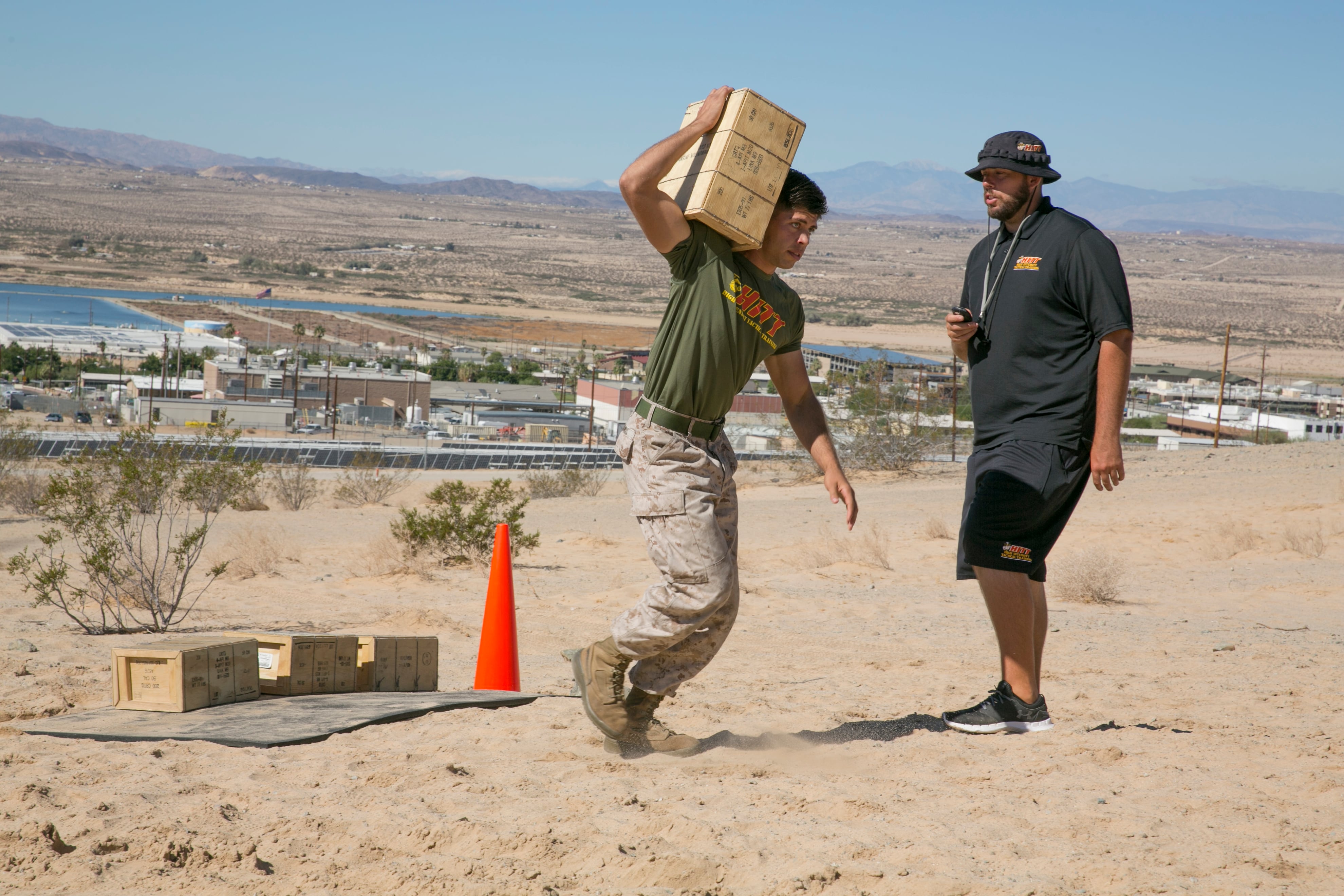
Lance Cpl. Jose Ramos, a motor transportation operator with Combat Logistics Battalion 7, carries an ammo crate during the uphill run. The course was approximately 400 yards long and Marines ran back down the course with a weighted vest, an ammo can and a mock M4 service rifle.
Photo Credit: Lance Cpl. Thomas Mudd/Marine Corps
Competition organizers are at work planning next year's event. Marines looking to compete will have a chance first to match up with beat out other Marines on their base. If they win that competition, they'll ship off to Twentynine Palms where they'll face off against the rest of the best, so the time to start preparing is now.
"It was an absolute pleasure to even be there — I couldn't be more happy to compete with some of the top athletes in the Marine Corps," said Schoener who serves in Marine Corps Air Station Yuma's provost marshal's office.
But it was stressful, she added.
"When I won it felt great," said Boozer, an ammunition technician with 1st Tank Battalion at Twentynine Palms. "I had some guys in my unit come by to watch me and my sergeant major. When they called my name I saw a big smile on Sgt. Maj. [Brian] Priester's face."
He credits Priester with getting him involved in the base-specific HITT competitions earlier this summer that he won to qualify for the Corps-wide competition.
Finding the Corps' top athletes
The HITT Championship was events were designed to test all aspects of fitness that are necessary on a chaotic and unpredictable battlefield where Marines could be called on to run ammunition cans between fights ing emplacement, drag wounded comrades out of the line of fire or haul themselves over a wall in full battle rattle.
The varied nature of the events meant that competitors had to be physically well-rounded to succeed, said Ryan Massimo, Semper Fit's combat fitness program manager.
"The great part about having five events with very different goals is that it provides Marines the opportunity to show their strengths," he said Ryan Massimo, Semper Fit's combat fitness program manager. "But it also tests their weaknesses, and at the end of the day shows who is the ultimate tactical athlete."
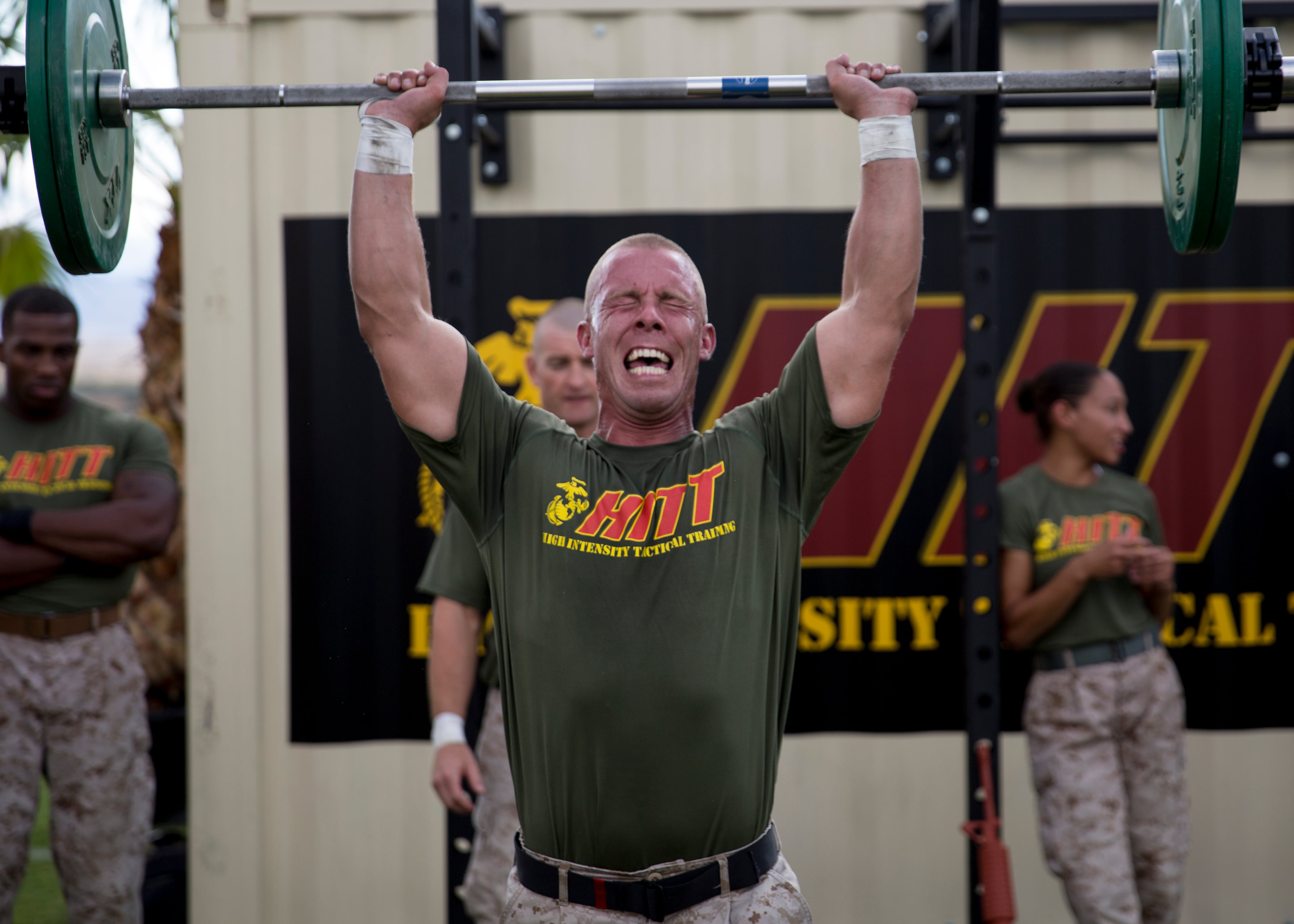
Sgt. Justin Mears, a retail manager at Marine Corps Logistics Battalion Barstow, Calif., competes in the military press during the battle skills challenge portion of the championship. Thirty two Marines from across the Corps competed against each other during the three-day competition.
Photo Credit: Lance Cpl. Connor Hancock/Marine Corps
HITT became part of Marines' physical training regimen in October 2012. The functional fitness program, somewhat similar to CrossFit, includes pre-set workouts with hundreds of exercises that complement the various phases of a Marine's deployment cycle. The exercises emphasizeing injury prevention through balanced fitness by incorporating endurance, flexibility and explosive strength.
"It was an absolute pleasure to even be there — I couldn't be more happy to compete with some of the top athletes in the Marine Corps," said Schoener who serves in Marine Corps Air Station Yuma's provost marshal's office.
But it was stressful, she added.
Those elements could be seen across the competition, with Marines flipping Humvee tires, carrying 140-pound dummies, doing pullups while wearing weighted vests, and firing weapons between sprints. [[Are all of those descriptions accurate? GH///Yes. JKS]]
Schoener said it was nerve wracking to compete against Marines she knew were top performers.
"The nervous jitters like most Marines feel before every [Physical and Combat Fitness testsphysical fitness] and [combat fitness] test was amplified because we knew we were competing against Marines who could probably out PT us on any given day," she said.
Boozer said his greatest struggle was endurance. During one event called the tactical hill climb, the Marines were tasked with running 400 yardsyears uphill in four 100-yard legs. Each leg, they were given a new item to carry: a heavy pack, when compared to other top-notch athletes is endurance.The uphill event – the Tactical Hill Climb -- required endurance as Marines completed four 400-yard uphill legs first with a heavy pack, then a crew-served weapon, a dummy, and finally a Humvee tire.
At the top of the hill, Marines had to catch their breath and to effectively shoot using a weapons simulator for score. After they were scored on their shooting, Finally, they ran back down the hill.
Boozer said it was by far the most challenging event.
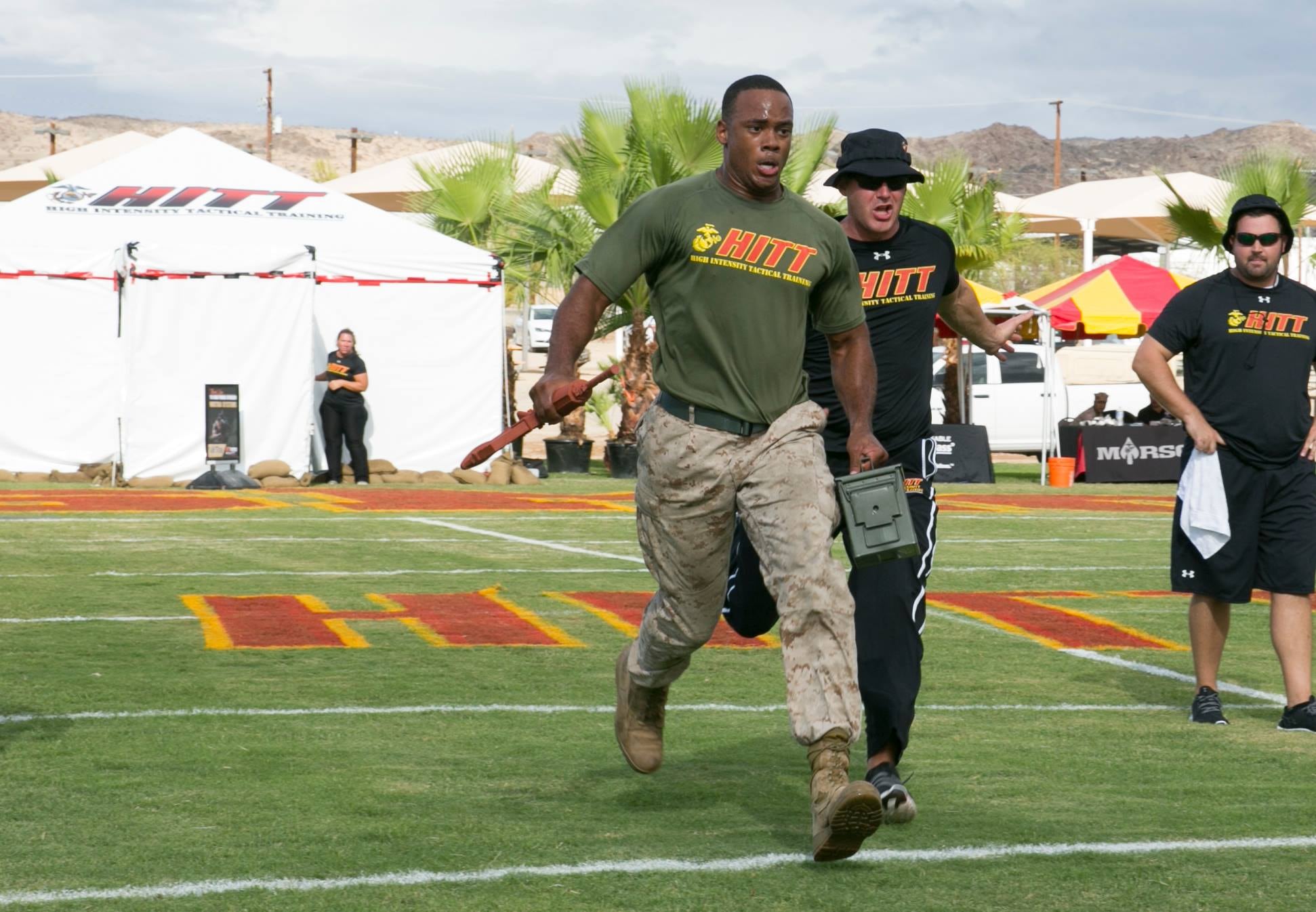
Cpl. Joshua Boozer runs back to his station after shooting in the Indoor Simulated Marksmanship Trainer tent. The competition tested Marines' functional fitness in areas like power, agility, endurance and mobility.
Photo Credit: Lance Cpl. Thomas Mudd/Marine Corps
"I believe the most challenging part was the event where we ran uphill because normally I am weak when it comes to long-distance running," he said. "My strength is from sprinting and strength," he said.
The uphill event – the Tactical Hill Climb -- required endurance as Marines completed four, 400-yard uphill legs first with a heavy pack, then a crew served weapon, then a dummy, and finally a Humvee tire. At the top, Marines had to catch their breath to effectively shoot using a weapons simulator for score. Finally, they ran back down the hill.
It So, while Boozer said it "took a lot of heart" to push through events like that, Boozer said, so himself in the events where he was weakest, he developed a strategy to pull ahead in events more suited to his strengths: sprinting and heavy lifting where he knew he was strongest.
"I excelled the most on day one where I knew the events would consist of a lot of sprinting and quick stuff," he said. "So, I knew I wanted to blow that out of the water and beat my competition there to start out well and make up for lost points on the other events."
The strategy worked. There is no question both Boozer and Schoener set the bar. Exactly what that bar was though is a bit of a mystery. While they unquestionably won, organizers say, the official carrying the score cards in his pocket was doused with a bucket of liquid during a post-competition celebration, ruining the written records.
For Schoener, events that required lifting oddly shaped objects were the toughest, she said. That included carrying a 90-pound ballistic rubber block, a 90-pound sandbag and a crew-served weapon. Some of those objects feel heavier or are more difficult to maneuver than standard exercise weights of a similar weight, competitors and organizers said.
Other events included a HITT assessment with a 25-yard dash, a standing long jump and agility cone drills. Marines also conducted as well as a rigorous battle skills challenge, which "Battle Skills Challenge" that included lifting heavy, oddly shaped objects like sand bags and ballistic rubber blocks. Those awkward items took many Marines out of their comfort zones as they grappled not just with the weight, but with the shape.
Improvement through competition
While this year is the service's first HITT championship, it has been in the works since soon after the HITT program was launched in October 2012.
Soon after the program's roll out Massimo started working to harness the Marines Corps' inherently competitive culture.
"We formed a HITT advisory committee about three years ago and started talking about having a Marine Corps-wide competition that exemplifies athleticism and includes what Marines like in terms of competition," Massimo said.
At its core, the idea is to tap into the natural competitive drive Marines have as a way to get more of them involved and push them harder to ultimately hone combat conditioning.
It is working.
Motivation through competition
Days after the first competition ended, Jackson and his team already began the planning phases for next year's competition at Twentynine Palms.
The intention now is to now host the best tactical athletes from every installation across the Corps every year at Twentynine Palms.
"We are already beginning to draw the planning phases for next year," Jackson said.
Like this year, they plan to first host a competition at every installation that will crown a top male and female competitor at each base. those top athletes will earn the right to attend the corps-wide competition by first being crowned their installation's female or male champion. MCCS organized a standardized set of qualification events at every installation around the world, Massimo said. to determine who were the strongest.
Each In all, installations held three events this summer. between July 1 and Aug. 1. The first was a kettlebell-burpee challenge in which Marines had to complete a series of kettlebell swings and standard burpees every Marine is familiar with. The second event was a 400-yard tactical course that included a tire flip, a sandbag carry, a fireman's carry and a sprint — each for 100 yards. The third was the standard HITT performance assessment, which tests power, agility, endurance and mobility. That included with a standing broad jump; and a kneeling power ball throw; speed with a 25-yard dash; drills that require Marines to agility with a prone 5-10-5 drill and a prone 3-cone drill which both require Marines to quickly change direction while sprinting; and balance and coordination tests. movements that test balance. endurance with a 30-15 Intermittent Fitness Test that alternates running and recover periods; and finally mobility with a Functional Movement Screen that tests balance and coordination.
The base and Corps-wide competitions are tough, but Jackson, the master sergeant who helped organize them, said Marine camaraderie was on display throughout. Even with the strong competition, there was a pervasive element of comradery according to both organizers and competitors.
"Nobody dropped," Jackson said."They are tactical athletes, warriors, out there," he said. "They are competing, but they are also cheering each other on. The morale is high. I don't think any of their peers would let them stop."
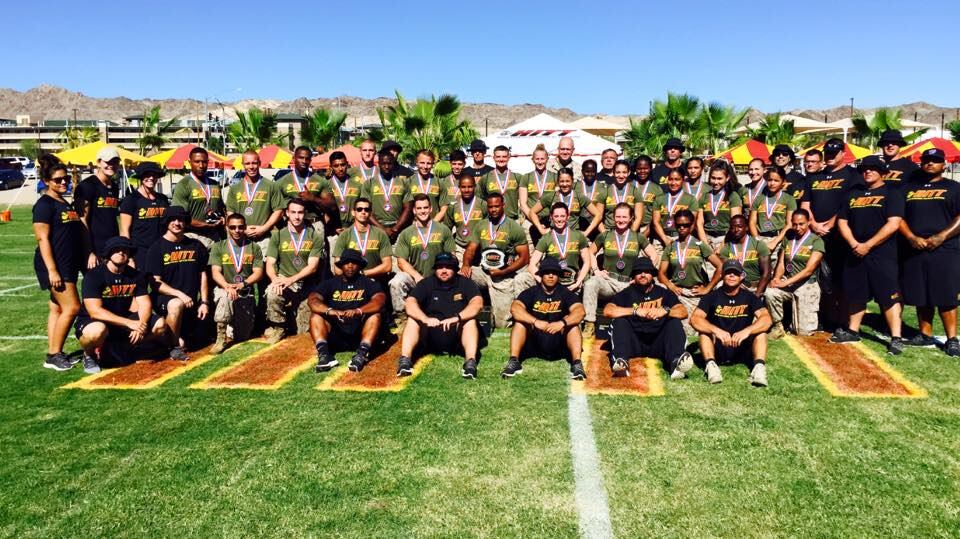
Nearly three dozen Marines from almost every one of the Corps' major installations competed during the first High Intensity Tactical Training Athlete Championship in California. The championship will now be an annual servicewide competition.
Photo Credit: Marine Corps
Both champions said competing against other athletic Marines helped motivate them.
"For me, I'm driven by my competitive spirit," Boozer said. "I love to compete. It is probably the only time you see me putting out my most — when I want to show I'm better than my peers."
Schoener agrees, and said that sense of teamwork is a common theme in the Marine Corps. with the value and utility of competition when working out among peers.
"The way [my peers] that they pushed me, I would want every Marine to feel that camaraderie comradery on a daily basis," she said. "We are our biggest supporters and also our biggest competitors. You wanted to win, but at the same time you were just as willing to yell and give advice to your potential competitor or somebody that could beat you."
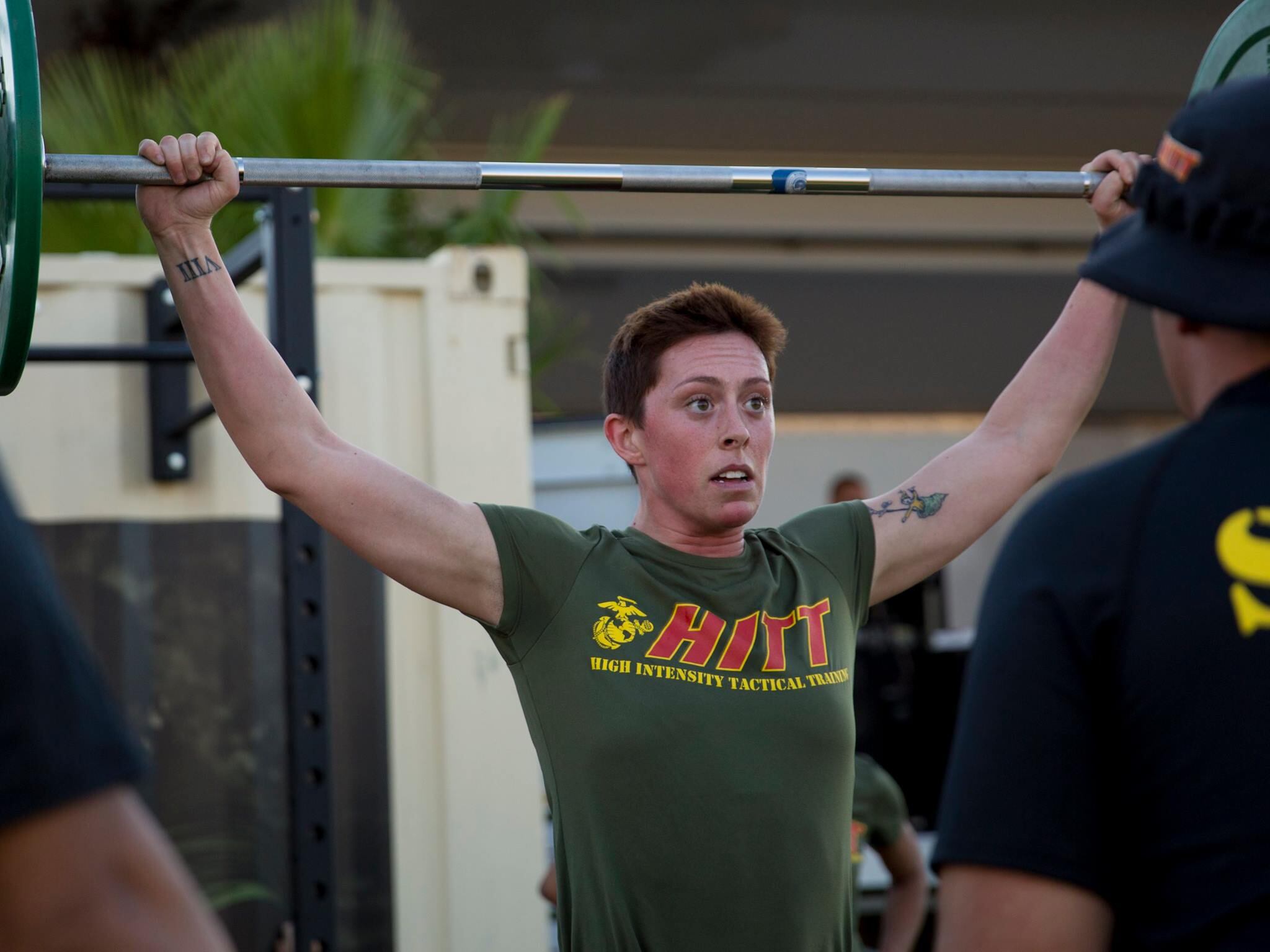
Staff Sgt. Lauren Schoener, the Corps' first female High Intensity Tactical Training Ultimate Athlete champion, competes in the military press during the battle skills challenge portion of the competition. Schoener said the camaraderie among Marines during the competition helped motivate her.
Photo Credit: Lance Cpl. Connor Hancock/Marine Corps
Even those who weren't performing as well as the winners Both Schoener or and Boozer were determined to see each event through, Schoener said. , who were interviewed separately, agreed.
"Nobody would quit," she said. "Even if it took them 30 minutes to complete something it took someone else four, they just didn't give up. Everyone attacked their weaknesses and wouldn't take no for an answer. I think that was the most important part everyone learned from the competition — to just dig deep and get it done."
But their desire to see their fellow Marines succeed didn't lessen the thrill of winning.
Next year, both champions said they plan to defend their titles.
"I will most definitely be back," Boozer said confidently.





